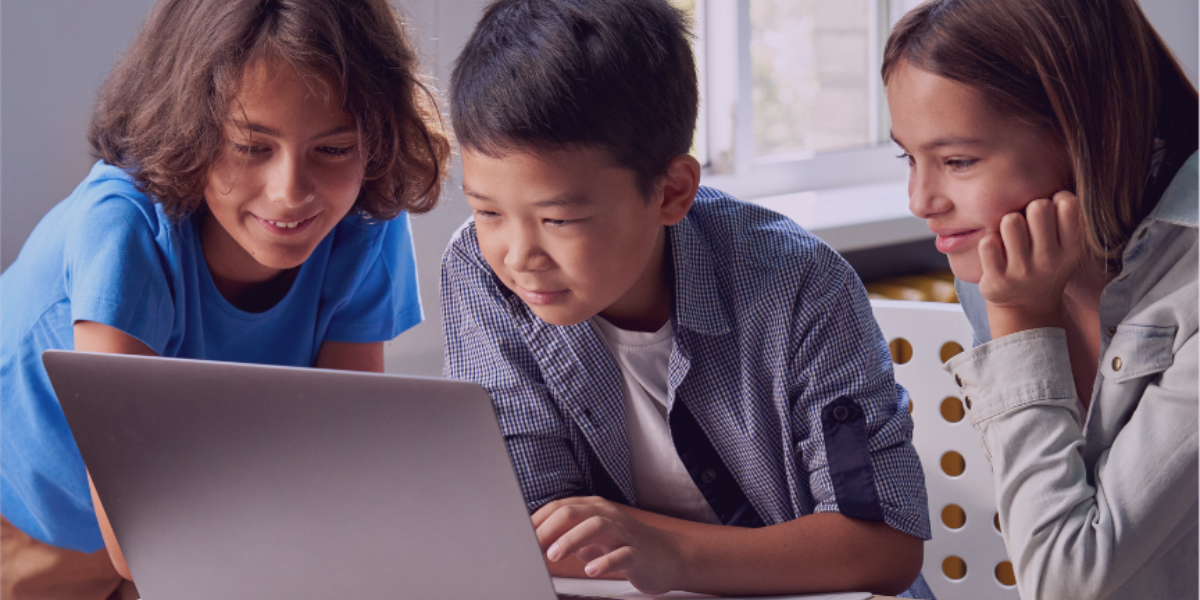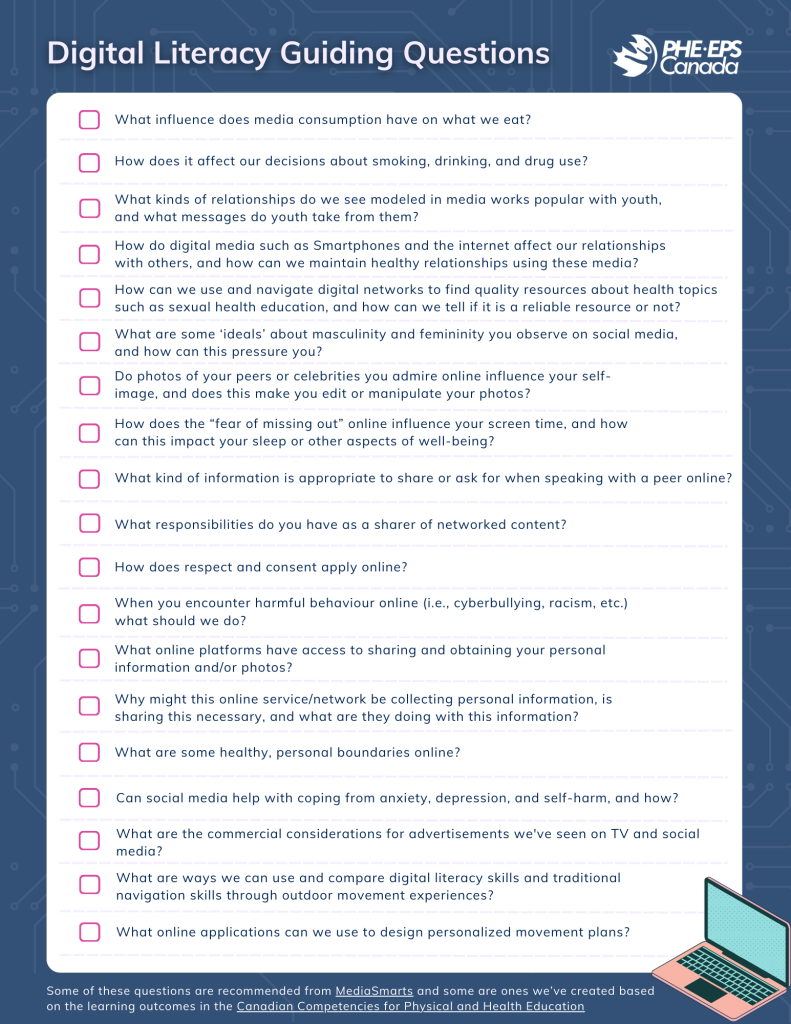Ways to include Digital Literacy in Physical and Health Education

With the growing concern of internet safety and privacy issues, we understand how important it is for children and youth to engage safely online. Many of your students are connected to, and are living in, a digital world where various online platforms are accessible at their fingertips. Your students' digital literacy skills are put to the test constantly, through interacting and sharing online content and/or creating and publishing their own.
Safer Internet Day (SID) is a great opportunity for schools and teachers to put an emphasis on digital literacy, particularly on the issues of online privacy, safety, and ethical use of technology. Internationally each year, SID takes place in February with this year's event happening on Tuesday, February 6th, 2024. SID is a day dedicated to “raising awareness of a safer and better internet for all, and especially for children and young people.”
What is digital literacy?
The Canadian Competencies for Physical and Health Education defines digital literacy as part of digital citizenship, which can be conceptualised as norms of behaviour regarding the use of digital technologies (Mezzanotte, 2020). It requires both educational and technological competence, as well as access to technology. Learning to be discerning consumers of educational and technological competence will help [students] now and in the future, to make good decisions surrounding their health, well-being, and more generally in other areas of their civic, educational, and social lives (Schleicher, 2022). In addition, digital citizens possess the skills to engage in online and offline communities actively, responsibly, and positively. Scholars argue for inclusion of online engagement in the digital literacy definition alongside respectful and tolerant behaviour towards others (UNICEF, 2017).
Why teach digital literacy in Physical and Health Education?
“Children need the skills to discern fact from fiction, to determine the quality of information they consume, and to be able to find trustworthy sources online especially when it comes to their health and well-being.” (Schleicher, 2022).
Teaching digital literacy in Physical and Health Education (PHE) should be, and can be, incorporated often. PHE are critical aspects of a wholistic elementary and secondary education and support the acquisition of real-world competencies to be used throughout their lives to live well. The Canadian Competencies for Physical and Health Education lists digital literacy as part of the foundational elements to creating a wholistic physical and health education curriculum. Research shows that individuals engaging in high quality and wholistic health and wellness education are more likely to be active users of digital technologies, and able to engage in information seeking, whether for socialization, searching for health information or schoolwork (Schleicher, 2022).

There are many emerging digital issues that children and youth are experiencing online and it is important for PHE teachers to be aware of them. ProctectKidsOnline.ca, operated by the Canadian Centre for Child Protection, has information geared towards parents/guardians about online dangers that teachers could use to inform their students and to teach how to navigate them. The current emerging digital issues that students from ages 5 to 15 could experience are:
- 5-7 years of age: Exposure to inappropriate content by clicking advertisements and suggested links
- 8-10 years of age: Cyberbullying, online luring, and exposure to sexually explicit material
- 11-12 years of age: Cyberbullying, online luring, and exposure to sexually explicit material
- 13-15 years of age: Cyberbullying, online luring, self/peer exploitation, non-consensual distribution of intimate images, sextortion, and exposure to sexually explicit material
How can I teach digital literacy in Physical and Health Education?
When students recognize and understand how to access multimedia and navigate digital networks, use digital and media tools, critically evaluate and analyze the content they are interacting with, and can express themselves and connect with friends online safely, many digital issues can be avoided (MediaSmarts, 2010). To address the variety of digital emerging issues, the Canadian Competencies for Physical and Health Education recommend provincial and territorial curriculums to begin introducing digital literacy concepts as early as grade 2 to build students’ digital citizenship. For example, under the ‘Living Well’ framework for Health and Wellness Education, grade 2 students' digital literacy learning outcome would be to “identify how to know what private information is and when it is safe to share their own and others’ information”. An example of demonstrating this learning outcome could be to “recognize how digital sharing can have consequences on the self and others’ (pg. 35).
Digital literacy model (MediaSmarts)
There is a lot of potential for cross-curricular opportunities when teaching digital literacy as many digital issues and trends are topics seen in various PHE provincial or territorial curricula expectations. Teaching this isn’t always straight forward, but MediaSmarts has a three part digital literacy model to help teach students:
- Key Concepts: What “students need to understand to be media literate” (i.e., critical questions and understand media).
- Core Competencies: What “they need to be able to do” (i.e., access, use, understand and engage).
- Framework Topics: What they need to know (i.e., how to “make good choices about privacy, ethics, safety and verifying information”).
Digital literacy learning examples (PHE Canada)
If you are looking for ways to incorporate digital literacy in Physical and Health Education lessons, we encourage you to explore the variety of digital literacy learning examples within the Canadian Competencies for Physical and Health Education. Below are some grade specific examples you would find in the Canadian Competencies for Physical and Health Education:
Grades 3 - 5:
Identity and Relationships:
- Outcome: Develop online communication and social media strategies that support positive and safe relationships with self and others
- I Can Exemplar: Access valid and reliable information on discrimination (e.g., the roles of the victim, perpetrator, by/outstander, ally, coconspirator) and resources for support
- Outcome: Analyze how media portrayals and stereotypes can influence behaviour, body positivity, and positive sense of self
- I Can Exemplar: Critique media depictions of sexuality, gender identity, ability, and race and their impact on self-image
Living Well:
- Outcome: Describe ways to protect privacy while using and interacting on devices and the internet
- I Can Exemplar: Practice using decision-making processes for social media posting (e.g., how to avoid saying something in a text or on social media that would not be said face-to-face)
Environment and Community Connections:
- Outcome: Connect how digital resources affect and can enhance movement and physical activity participation
- I Can Exemplar: Source a variety of digital tools that can be utilized to enhance movement experiences (e.g., apps, websites)
Grades 6 - 8:
Identity and Relationships:
- Outcome: Use boundaries to keep self and others safe online
- I Can Exemplar: Craft a digital footprint with the understanding that it is an opportunity to present what the world sees & Practice strategies that limit digital technology risks and ways to seek help and emotional support if inappropriate messages or pictures are received (e.g., cyber bullying, unwanted communication, images)
Living Well:
- Outcome: Determine what a positive digital profile entails and actions necessary to maintain appropriate algorithms
- I Can Exemplar: Promote a positive digital profile and ways to protect against consequences
Environment and Community Connections:
- Outcome: Apply digital literacy to enhance movement experiences & Explore the effectiveness of online games to promote health and well-being (e.g., Zombie Run, Pokémon Go, Just Dance, Ring Fit Adventure)
- I Can Exemplar: Pitch an interactive game to promote movement, and health and well-being
Grades 9 - 12/CEGEP:
Identity and Relationships:
- Outcome: Express healthy digital limits and ways to address misuse or addiction (e.g., social media, use of technology, gaming, online shopping, gambling)
- I Can Exemplar: Examine wholistic strategies to self-regulate to manage problematic habits online and constructive ways to deal with others inappropriate or harmful behaviours online (e.g., inadequate sleep, disordered eating, self-harm, cyberbullying, scams)
Living Well:
- Outcome: Scrutinize advertising to discover bias and messages that may affect decisions
- I Can Exemplar: Critically analyze information found on the internet (e.g., create culture jams that address misinformation or challenge biased mainstream media messages)
Environment and Community Connections:
- Outcome: Explore the role of digital literacy skills to support practical movement experiences
- I Can Exemplar: Transfer digital literacy skills to enhance movement experiences (e.g., hiking to geocaching)
Guiding Questions
In addition, below are some guiding questions you can use when teaching digital literacy in your physical and health education classes. Some of these questions are recommended from MediaSmarts and some are ones we’ve created based on the learning outcomes in the Canadian Competencies for Physical and Health Education.

Download the Guiding Questions
Do you have any guiding questions, ideas, lessons, or resources to increase digital literacy amongst students in Physical and Health Education? Share your ideas with us via [email protected]
Additional Resources:
Check out these other digital literacy resources:
- Canadian Competencies for Physical and Health Education
- Protectkidsonline.ca
- Cyberbullying Resources for Grades 5-12 Teachers
- Cybertip.ca - Online Safety Resources
- Canada Safer Internet Day Committee - Canadian Centre for Child Protection
- MediaSmarts: Young Canadians in a Wireless World - “Canada’s longest running, and most comprehensive research study on young people’s attitudes and behaviours regarding the internet, surveying over 20,000 parents, teachers, and students since 2000.”
- MediaSmarts: Teacher Resources
- Safer Internet Day (SID): Resources
- What you need to know about internet addiction
References:
Davis, M., Gleddie, D.L., Nylen, J., Leidl, R., Toulouse, P., Baker, K., & Gillies, L. (2023).Canadian physical and health education competencies. Ottawa: Physical and Health Education Canada.
MediaSmarts. (2023). “Young Canadians in a Wireless World, Phase IV: Trends and Recommendations.” MediaSmarts. Ottawa.
MediaSmarts. (2010). “Key Concepts for digital literacy”. Retrieved from: https://mediasmarts.ca/digital-media-literacy/general-information/digital-media-literacy-fundamentals/key-concepts-digital-media%C2%A0literacy
Mezzanotte, C. (2020). Policy approaches and practices for the inclusion of students with attention-deficit hyperactivity disorder (ADHD), OECD Education Working Papers, No. 238, OECD Publishing, Paris. Retrieved from https://dx.doi. org/10.1787/49af95e0-en
Schleicher, A. (2022). Building on COVID-19’s innovation momentum for digital, inclusive education (International Summit on the Teaching Profession), OECD Publishing, Paris. doi. org/10.1787/24202496-en
UNICEF (2017). The state of the world’s children: Children in a digital world. Retrieved from http://www.soapbox.co.uk








